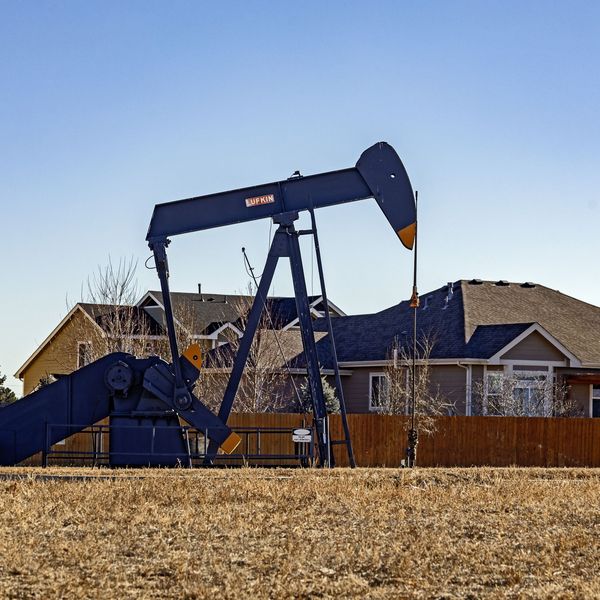Newly Exposed Methane Threat Trumps Latest 'False Solution' on Emissions
Previously overlooked natural gas gathering facilities spewing as much methane as 37 coal-fired power plants
Environmental groups are raising concerns about another "false solution" as the Obama administration proposes its new methane emissions rules on Tuesday.
Meanwhile, a new study revealed that those very emissions are "substantially higher" than official estimates, adding to the growing body of evidence showing that the proliferation of natural gas--even if "capped"--will only exacerbate climate change.
The study, led by researchers at Colorado State University and published Tuesday in the journal Environmental Science & Technology, found that natural gas gathering facilities lose about 100 billion cubic feet of natural gas a year, amounting to roughly eight times more than previous estimates used by the Environmental Protection Agency (EPA).
The facilities, which collect from multiple wells before distributing the gas to power plants and homes, have been overlooked by previous emission surveys. "Yet," notes Mark Brownstein, vice president of the Environmental Defense Fund's Climate and Energy Program, "they may be the largest methane source in the oil and gas supply chain."
The newly identified emissions "would increase total emissions from the natural gas supply chain in EPA's current Greenhouse Gas Inventory by approximately 25 percent if added to the tally," Brownstein notes.
Further, the methane emitted "packs the same 20-year climate impact as 37 coal-fired power plants" and is said to be 87 times as potent as carbon dioxide.
The new research follows another study that found faulty instruments used to measure methane emissions. Current assessments underestimate emission rates "by factors of three to five."
The White House and other politicians have championed natural gas as a "green" alternative to coal and oil. However, research into its environmental impacts—whether from fracking or methane emissions—has shown it to be increasingly unviable. On Tuesday, the Obama administration released its first-ever plan to reduce methane emissions as part of its new climate strategy. The proposed standards would cap the methane and volatile organic compounds (VOCs) emitted from new and modified oil and gas facilities.
While individuals who live close to fossil fuel facilities welcomed the rule as a major public health effort, environmentalists said it neglected to account for the significant emissions from older wells and did not go nearly far enough to address climate change.
"The regulation of methane cannot become a justification for continuing our reliance on fossil fuels," said Friends of the Earth climate and energy campaigner Kate DeAngelis. "The real solution to climate change is to leave fossil fuels in the ground and to clean up the abandoned wells that continue to poison our air."
And Wenonah Hauter, executive director of Food & Water Watch, agreed, saying that the rules "could not possibly hold off the growing climate crisis."
Rather, Hauter added, "These regulations would wrongly promote natural gas as a 'clean' alternative to oil and coal. These weak regulations suggest that pursuing natural gas benefits the environment, justifying continuing to drill and frack."
An Urgent Message From Our Co-Founder
Dear Common Dreams reader, The U.S. is on a fast track to authoritarianism like nothing I've ever seen. Meanwhile, corporate news outlets are utterly capitulating to Trump, twisting their coverage to avoid drawing his ire while lining up to stuff cash in his pockets. That's why I believe that Common Dreams is doing the best and most consequential reporting that we've ever done. Our small but mighty team is a progressive reporting powerhouse, covering the news every day that the corporate media never will. Our mission has always been simple: To inform. To inspire. And to ignite change for the common good. Now here's the key piece that I want all our readers to understand: None of this would be possible without your financial support. That's not just some fundraising cliche. It's the absolute and literal truth. We don't accept corporate advertising and never will. We don't have a paywall because we don't think people should be blocked from critical news based on their ability to pay. Everything we do is funded by the donations of readers like you. Will you donate now to help power the nonprofit, independent reporting of Common Dreams? Thank you for being a vital member of our community. Together, we can keep independent journalism alive when it’s needed most. - Craig Brown, Co-founder |
Environmental groups are raising concerns about another "false solution" as the Obama administration proposes its new methane emissions rules on Tuesday.
Meanwhile, a new study revealed that those very emissions are "substantially higher" than official estimates, adding to the growing body of evidence showing that the proliferation of natural gas--even if "capped"--will only exacerbate climate change.
The study, led by researchers at Colorado State University and published Tuesday in the journal Environmental Science & Technology, found that natural gas gathering facilities lose about 100 billion cubic feet of natural gas a year, amounting to roughly eight times more than previous estimates used by the Environmental Protection Agency (EPA).
The facilities, which collect from multiple wells before distributing the gas to power plants and homes, have been overlooked by previous emission surveys. "Yet," notes Mark Brownstein, vice president of the Environmental Defense Fund's Climate and Energy Program, "they may be the largest methane source in the oil and gas supply chain."
The newly identified emissions "would increase total emissions from the natural gas supply chain in EPA's current Greenhouse Gas Inventory by approximately 25 percent if added to the tally," Brownstein notes.
Further, the methane emitted "packs the same 20-year climate impact as 37 coal-fired power plants" and is said to be 87 times as potent as carbon dioxide.
The new research follows another study that found faulty instruments used to measure methane emissions. Current assessments underestimate emission rates "by factors of three to five."
The White House and other politicians have championed natural gas as a "green" alternative to coal and oil. However, research into its environmental impacts—whether from fracking or methane emissions—has shown it to be increasingly unviable. On Tuesday, the Obama administration released its first-ever plan to reduce methane emissions as part of its new climate strategy. The proposed standards would cap the methane and volatile organic compounds (VOCs) emitted from new and modified oil and gas facilities.
While individuals who live close to fossil fuel facilities welcomed the rule as a major public health effort, environmentalists said it neglected to account for the significant emissions from older wells and did not go nearly far enough to address climate change.
"The regulation of methane cannot become a justification for continuing our reliance on fossil fuels," said Friends of the Earth climate and energy campaigner Kate DeAngelis. "The real solution to climate change is to leave fossil fuels in the ground and to clean up the abandoned wells that continue to poison our air."
And Wenonah Hauter, executive director of Food & Water Watch, agreed, saying that the rules "could not possibly hold off the growing climate crisis."
Rather, Hauter added, "These regulations would wrongly promote natural gas as a 'clean' alternative to oil and coal. These weak regulations suggest that pursuing natural gas benefits the environment, justifying continuing to drill and frack."
Environmental groups are raising concerns about another "false solution" as the Obama administration proposes its new methane emissions rules on Tuesday.
Meanwhile, a new study revealed that those very emissions are "substantially higher" than official estimates, adding to the growing body of evidence showing that the proliferation of natural gas--even if "capped"--will only exacerbate climate change.
The study, led by researchers at Colorado State University and published Tuesday in the journal Environmental Science & Technology, found that natural gas gathering facilities lose about 100 billion cubic feet of natural gas a year, amounting to roughly eight times more than previous estimates used by the Environmental Protection Agency (EPA).
The facilities, which collect from multiple wells before distributing the gas to power plants and homes, have been overlooked by previous emission surveys. "Yet," notes Mark Brownstein, vice president of the Environmental Defense Fund's Climate and Energy Program, "they may be the largest methane source in the oil and gas supply chain."
The newly identified emissions "would increase total emissions from the natural gas supply chain in EPA's current Greenhouse Gas Inventory by approximately 25 percent if added to the tally," Brownstein notes.
Further, the methane emitted "packs the same 20-year climate impact as 37 coal-fired power plants" and is said to be 87 times as potent as carbon dioxide.
The new research follows another study that found faulty instruments used to measure methane emissions. Current assessments underestimate emission rates "by factors of three to five."
The White House and other politicians have championed natural gas as a "green" alternative to coal and oil. However, research into its environmental impacts—whether from fracking or methane emissions—has shown it to be increasingly unviable. On Tuesday, the Obama administration released its first-ever plan to reduce methane emissions as part of its new climate strategy. The proposed standards would cap the methane and volatile organic compounds (VOCs) emitted from new and modified oil and gas facilities.
While individuals who live close to fossil fuel facilities welcomed the rule as a major public health effort, environmentalists said it neglected to account for the significant emissions from older wells and did not go nearly far enough to address climate change.
"The regulation of methane cannot become a justification for continuing our reliance on fossil fuels," said Friends of the Earth climate and energy campaigner Kate DeAngelis. "The real solution to climate change is to leave fossil fuels in the ground and to clean up the abandoned wells that continue to poison our air."
And Wenonah Hauter, executive director of Food & Water Watch, agreed, saying that the rules "could not possibly hold off the growing climate crisis."
Rather, Hauter added, "These regulations would wrongly promote natural gas as a 'clean' alternative to oil and coal. These weak regulations suggest that pursuing natural gas benefits the environment, justifying continuing to drill and frack."

